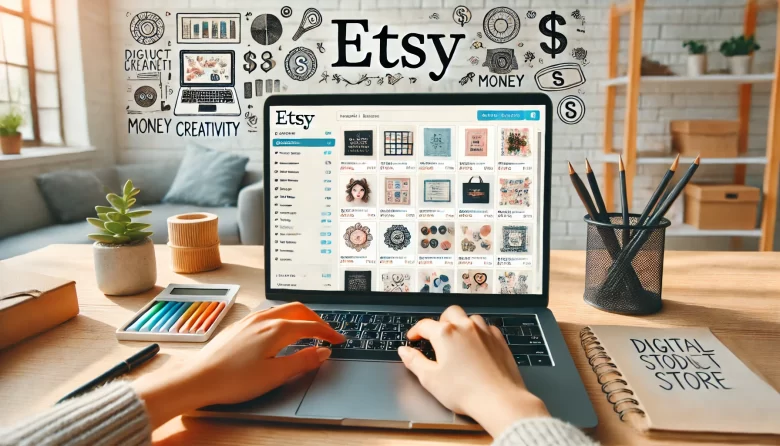With the rise of e-commerce and the creator economy, more people are looking for ways to earn income by selling their knowledge, creativity, or skills. One of the best platforms for selling digital products is Etsy, a global marketplace known for handmade and creative goods.
What many people don’t realize is that Etsy is not just for physical products. It’s also a great platform to sell digital downloads—which means you can create once and sell infinitely, without handling inventory or shipping.
In this guide, you’ll learn step-by-step how to create a store on Etsy and start selling digital products—even if you’re a complete beginner.
Why Sell Digital Products on Etsy?
Digital products are files that your customers download after purchase. This includes things like:
- Printable planners
- Wedding invitations
- Business templates
- Digital art or wall decor
- Lightroom presets
- Canva templates
- eBooks or guides
- SVG files for crafters
- Worksheets and educational tools
Here’s why selling digital products is so powerful:
- ✅ Passive income potential
- ✅ No shipping, packaging, or stock
- ✅ Lower costs and higher margins
- ✅ Huge market of buyers already on Etsy
- ✅ You can start from home with basic tools
Step 1: Choose Your Niche and Product Type
Before opening your store, you need clarity on:
- Who you’re selling to
- What kind of problems your digital product solves
Some great niches for digital products include:
- Organization (planners, calendars)
- Small business (logo kits, social media templates)
- Weddings and events (invitations, signage)
- Home decor (printable art)
- Self-improvement (journals, trackers)
- Teachers and students (lesson plans, flashcards)
Tip: Use Etsy’s search bar to see what types of digital products are already selling. Look for gaps or opportunities to improve.
Step 2: Create Your Etsy Account and Open a Shop
To get started:
- Go to www.etsy.com
- Click on “Sell on Etsy” in the top menu
- Click “Get Started” and create your seller account
You’ll be asked to:
- Choose your shop name (make it memorable and relevant)
- Select your shop language, country, and currency
- Decide how you’ll get paid (connect your bank account or PayPal)
- Set up billing info (for listing fees and ads)
💡 Etsy charges $0.20 per listing, plus a small transaction and processing fee when you make a sale.
Step 3: Design and Prepare Your Digital Product
Your digital product needs to be valuable, well-designed, and easy to use. Depending on your product, you can use tools like:
- Canva – perfect for templates, planners, journals
- Adobe Illustrator or Photoshop – for illustrations, SVGs
- Microsoft Word or Google Docs – for ebooks or printables
- Procreate – for hand-drawn art and designs
When saving your file, use common formats:
- PDF for printables and planners
- PNG/JPG for digital art
- SVG for craft files
- .ZIP if you’re delivering multiple files
⚠️ Make sure the files are high-quality and formatted correctly. Test them before uploading.
Step 4: Create a High-Converting Listing
Your product listing is what will convince a buyer to make a purchase. A great listing includes:
1. Product Title
Include relevant keywords people might search for. Example: “Weekly Digital Planner for iPad | Undated | Goodnotes + PDF Included”
2. Product Description
Write clear, persuasive copy that includes:
- What the product is
- What the buyer receives
- How to use it
- File formats included
- Terms of use (especially for templates or commercial use)
3. Tags and SEO
Etsy allows you to add up to 13 tags. Use keyword phrases people would actually type in to find your product.
Example:
- “printable planner”
- “digital to-do list”
- “A4 planner PDF”
- “minimalist planner”
Use tools like EtsyHunt or eRank to find high-volume, low-competition keywords.
4. Upload Product Files
Attach the digital file (or a ZIP folder) to the listing. Etsy will deliver it automatically after purchase.
5. Add Stunning Images
Your listing images are crucial—buyers don’t see the real product, so mockups matter!
Use tools like:
- Canva for mockups
- SmartMockups for showcasing templates on a screen
- Styled scenes to simulate how the product looks when used
Etsy allows 10 photos—use as many as possible to build buyer confidence.
Step 5: Set the Right Price
Pricing digital products depends on:
- Complexity
- Time spent creating
- Niche and competition
- Value to the buyer
Examples:
- Simple planner: $3–$7
- Canva template bundle: $10–$25
- Wedding invitation suite: $15–$50
- SVG files: $2–$5
You can also bundle products or offer discounts on multi-item purchases.
Step 6: Create Store Branding That Builds Trust
Your shop should look polished and professional. Focus on:
- Logo and banner: Design a clean visual identity using Canva
- Shop bio: Introduce yourself and what your shop is about
- Policies: Write clear refund and usage policies for digital downloads
- FAQs: Address common questions (e.g., how to download files)
Remember: Customers are more likely to buy from a store that looks trustworthy and established.
Step 7: Promote Your Etsy Store
Once your listing is live, don’t wait passively. Promote it!
Free strategies:
- Post on Pinterest (great for printables, planners, art)
- Use Instagram or TikTok to showcase your product
- Share in Facebook groups (if allowed)
- Post on Reddit in niche communities
Paid strategies:
- Run Etsy Ads to appear in search results
- Use Pinterest Ads to drive traffic to your listing
- Run Instagram promotions to boost visibility
Also, consider building an email list or using a link-in-bio tool to create a mini-funnel.
Tips to Succeed Selling Digital Products on Etsy
✅ Focus on quality, not quantity
✅ Create beautiful visuals and helpful descriptions
✅ Optimize for SEO with every listing
✅ Test and improve over time
✅ Ask buyers for reviews after purchases
✅ Study what’s trending in your niche
✅ Add new products regularly
Scaling Your Etsy Digital Product Business
Once you’ve validated your first product, here are ways to scale:
- Create bundles or collections
- Offer commercial licenses
- Launch a second niche store
- Build a presence outside Etsy (e.g. your own site)
- Add passive income streams like courses or affiliate links
Final Thoughts: Start Simple, Start Today
Selling digital products on Etsy is one of the most accessible ways to earn online—whether you’re a designer, writer, entrepreneur, or creative hobbyist. You don’t need to ship anything, manage inventory, or invest heavily up front.
With the right niche, compelling products, and consistent marketing, your Etsy store can become a source of recurring, passive income.
The best part? You can start today, from your laptop.




